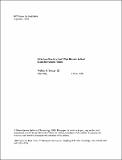| dc.contributor.advisor | Timothy Riddiough. | en_US |
| dc.contributor.author | Strange, William B. (William Bryan), 1948- | en_US |
| dc.contributor.author | Tang, Duo, 1972- | en_US |
| dc.contributor.other | Massachusetts Institute of Technology. Dept. of Urban Studies and Planning. | en_US |
| dc.date.accessioned | 2006-03-29T18:23:15Z | |
| dc.date.available | 2006-03-29T18:23:15Z | |
| dc.date.copyright | 2000 | en_US |
| dc.date.issued | 2000 | en_US |
| dc.identifier.uri | http://hdl.handle.net/1721.1/32195 | |
| dc.description | Thesis (S.M.)--Massachusetts Institute of Technology, Dept. of Urban Studies and Planning, 2000. | en_US |
| dc.description | Includes bibliographical references (leaves 72-73). | en_US |
| dc.description.abstract | This thesis examines the historical financial data for publicly traded securities issued by Real Estate Investment Trusts (REITS). The inquiry isolates certain quantifiable firm specific financial data and organizes that data into pooled, time-series cross-sections. Annual returns to capital are determined for certain equity REITS from 1990 to 1999 and are used as the dependent variable in a statistical regression analysis. The analysis includes independent variables drawn from a database and includes variables to adjust results for the impact of macroeconomic factors. In addition, indexes for the broader markets are identified and included in the regressions to adjust for the impact of trends in the general market. Following adjustments for macroeconomic factors and general market trends the regression results identify various firm specific variables that display a statistically significant relationship to relative returns to capital in REIT securities over time. Negative impacts on returns are observed for increases in firm size and for certain debt features such as variable rate debt, unsecured debt, and total debt. Positive impacts on returns are associated with higher levels of asset growth as well as relatively higher levels of secured debt and preferred stock. The expected positive correlation of returns with increases in broader stock market indexes and negative correlation with increasing short-term interest rates is not displayed. For the period from 1993 to 1999, the data indicate an inverse correlation of REIT returns to the stock market as represented by the S&P 500 index and a direct relation with short-term interest rates. Interpretations of the results are provided in a form that relates the firm level determinates of returns to capital with the history of REITS and their organizational and tax characteristics. Alternatives for further inquiry are identified and implications for investors and REIT managers are discussed. | en_US |
| dc.description.statementofresponsibility | by William B. Strange, III and Duo Tang. | en_US |
| dc.format.extent | 73 leaves | en_US |
| dc.format.extent | 3554320 bytes | |
| dc.format.extent | 3560658 bytes | |
| dc.format.mimetype | application/pdf | |
| dc.format.mimetype | application/pdf | |
| dc.language.iso | eng | en_US |
| dc.publisher | Massachusetts Institute of Technology | en_US |
| dc.rights | M.I.T. theses are protected by copyright. They may be viewed from this source for any purpose, but reproduction or distribution in any format is prohibited without written permission. See provided URL for inquiries about permission. | en_US |
| dc.rights.uri | http://dspace.mit.edu/handle/1721.1/7582 | |
| dc.subject | Urban Studies and Planning. | en_US |
| dc.title | Firm level factors that affect returns to real estate investment trusts | en_US |
| dc.type | Thesis | en_US |
| dc.description.degree | S.M. | en_US |
| dc.contributor.department | Massachusetts Institute of Technology. Department of Urban Studies and Planning | |
| dc.identifier.oclc | 48527946 | en_US |
